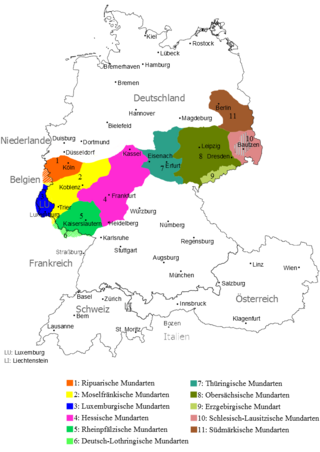
Back Ripuaries Afrikaans Ripuarische Dialekte ALS Franco ripuario AN لغة ريبوارية Arabic لغه ريبواريه ARZ Fráncicu ripuariu AST ریپواری دیلی AZB Рипуарски франконски езици Bulgarian Ripuarisch Catalan Ripuarština Czech
This article has multiple issues. Please help improve it or discuss these issues on the talk page. (Learn how and when to remove these template messages)
|
| Ripuarian | |
|---|---|
| Native to | Germany, Belgium, Netherlands |
| Region | North Rhine-Westphalia, Rhineland-Palatinate, Liège Province, Limburg |
Native speakers | (Kölsch: 250,000 cited 1997)[1] |
| Language codes | |
| ISO 639-3 | None (mis)Individual code: ksh – Kölsch |
| Glottolog | ripu1236 |
 Area where Ripuarian is spoken. Green = sparsely populated forest. | |
 Central German language area after 1945 and the expulsion of the Germans from the east. 1 = Ripuarian. | |
Ripuarian (/ˌrɪpjuˈɛəriən/ RIP-yoo-AIR-ee-ən; also Ripuarian Franconian; German: Ripuarisch, pronounced [ʁipuˈ(ʔ)aːʁɪʃ], ripuarische Mundart, ripuarischer Dialekt, ripuarisch-fränkische Mundart, Ribuarisch, Dutch: Ripuarisch [ripyˈʋaːris] , Noordmiddelfrankisch) is a German dialect group, part of the West Central German language group. Together with the Moselle Franconian which includes the Luxembourgish language, Ripuarian belongs to the larger Central Franconian dialect family and also to the linguistic continuum with the Low Franconian languages.
It is spoken in the Rhineland south of the Benrath line — from northwest of Düsseldorf and Cologne to Aachen in the west and to Waldbröl in the east.
The language area also comprises the north of the German-speaking Community of Belgium as well as the southern edge of the Limburg province of the Netherlands, especially Kerkrade (Kirchroa), where it is perceived as a variety of Limburgish and legally treated as such.[citation needed]
The name derives from the Ripuarian Franks (Rheinfranken), who settled in the area from the 4th century onward.
The most well known Ripuarian dialect is Kölsch, the local dialect of Cologne. Dialects belonging to the Ripuarian group almost always call themselves Platt (spelled plat in the Netherlands) like Öcher Platt (of Aachen), Bönnsch Platt (of Bonn), Eischwiele Platt (of Eschweiler), Kirchröadsj plat (of Kerkrade), or Bocheser plat (of Bocholtz). Most of the more than one hundred Ripuarian dialects are bound to one specific village or municipality. Usually there are small distinctive differences between neighbouring dialects (which are, however, easily noticeable to locals), and increasingly bigger differences between the more distant dialects. These are described by a set of isoglosses called the Rhenish fan in linguistics. The way people talk, even if they are not using Ripuarian, often allows them to be traced precisely to a village or city quarter where they learned to speak.
- ^ Ripuarian at Ethnologue (25th ed., 2022)

Kölsch at Ethnologue (25th ed., 2022)
© MMXXIII Rich X Search. We shall prevail. All rights reserved. Rich X Search